Incoming freshmen have been excluded from these previews, as we'd like to wait and see what they have to offer on the NCAA level before we come to any long-term conclusions.
-Top 20 NBA Prospects in the Big Ten
-Top 20 NBA Prospects in the ACC
-Top NBA Prospects in the Big XII #1
(#1) LeBryan Nash
-Top NBA Prospects in the Big XII #2-5
(#2) Myck Kabongo
(#3) Jeff Withey
(#5) Pierre Jackson
-Top NBA Draft Prospects in the Big XII, Part Three
(#4) Elijah Johnson (Video Scouting Report)
#6, Rodney McGruder, 6'4, Senior, Shooting Guard, Kansas State
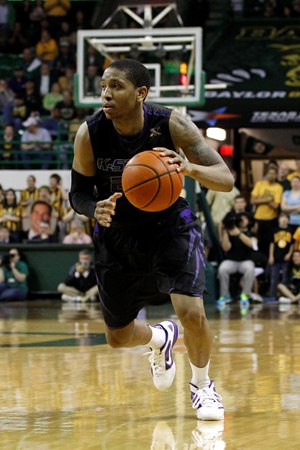
Matt Williams
A top-100 recruit in the RSCI coming out of high school, Rodney McGruder emerged as Kansas State's leading scorer last season as a junior. Keying the Wildcats to a NCAA Tournament run, the talented shooting guard ended the year ranked 7th in the Big XII in scoring at 16.2 points per-game, earning All-Big XII 2nd Team honors in the process. Returning to Manhattan for his senior year, McGruder will look to build his draft resume in a new system under first-year Head Coach Bruce Weber.
A 6'5 shooting guard with an average wingspan and solid frame, McGruder is a good, but not great athlete for his position at the college level. He has good speed and can finish plays above the rim when he has a head of steam, but doesn't have the type of elite leaping ability and quickness that would put him on par with the average NBA wing.
While McGruder may not be a prototypical athlete by NBA standards, or have much flash to his game, he has great toughness, played hurt for stretches last season, competes every game, and can score in a variety of ways at the NCAA level. McGruder's role last season revolved around his ability to take what defenses gave him when spotting-up on the perimeter or running off of screens.
Seldom asked to create his own shot one-on-one or run the pick and roll, nearly 40% of McGruder's field goal attempts are catch and shoot jumpers according to Synergy Sports Technology. Knocking down 40% of his career three-pointers coming into last season, McGruder shot a respectable 38.5% from distance as a junior, getting fewer open looks than he did earlier in his career. Looking out of rhythm and missing badly at times, McGruder is at his best when he can set his feet with space in a spot-up situation, rise, and fire.
When he's forced to put the ball on the floor, the Washington, D.C. native is not a prolific pull-up shooter, but has deft touch on his floater and isn't shy about aggressively taking the ball to the rim. He takes some difficult push shots from time to time, but is not prone to forcing such shots into the teeth of the defense. If McGruder can become a bigger threat to create offense with the ball in his hands, or post a career year shooting the ball from deep, he should find himself ranked among the very best scorers in the Big XII.
Defensively, McGruder plays with good intensity, contributes on the glass, and holds his own at this level. Lacking great length and quickness, the rising senior will get in a stance and aggressively close out shooters, but isn't a major factor in the passing lanes and will get caught being a bit too aggressive helping his teammates at times. He does a nice job defending comparably athletic players one-on-one, but his ability to defend his position at the NBA level is questionable.
Rodney McGruder figures to once again carry the load offensively for Kansas State, and what development he's able to show as he shoulders that burden will factor heavily into where he stands this spring. A potential candidate for the Portsmouth Invitational Tournament, McGruder will have ample opportunity to show what, if anything, he's added to his game to solidify his standing among shooting guards in the senior class.
#7, Jordan Henriquez, 7'0, Center, Senior, Kansas State
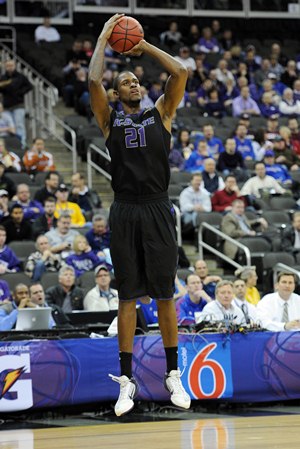
Kyle Nelson
Jordan Henriquez struggled with inconsistency for much of his junior season and did himself few favors when he was suspended for conduct detrimental to the team. Yet, he filled Kansas State's void in the middle, helped the Wildcats make a brief run in the NCAA Tournament, and really took a step forward in his development. The question now is whether Jordan Henriquez can take the next step, building on his late season emergence, to convince scouts that he is a legitimate prospect.
Though Henriquez stands around 7'0 with very long arms and a frame that still looks skinny at 250-pounds, he struggles to hold his own against centers at the NCAA level and must continue to get stronger. This development is particularly important given that he's only an above-average athlete for his size. Henriquez lacks elite explosiveness and quickness in the open floor to compensate for his lack of strength. Improving his physique could help him maximize his athleticism, but it is remains to be seen how much he can continue to develop physically and athletically given that he is already 23-years-old.
On the offensive end of the floor, Henriquez was one of the least productive scores among centers in our database. While he made major strides in his shooting efficiency, he scored just 7.6 points per game in just over 20 minutes per game and took less than 10% of Kansas State's shots.
Henriquez finds most of his attempts around the basket, usually off of cuts and while posting up. While he looks solid by the numbers at 54.4% 2FG, he doesn't appear to have the greatest hands and sometimes struggles to power through big and athletic post defenders to finish in traffic. Additionally, he struggles to carve out space on the block against more aggressive defenders and doesn't have much in the way of post moves.
He does do a good job, however, hustling hard on the offensive boards and cleaning up missed shots. He could improve even further in this area if he relied less upon his physical gifts and worked more on his fundamentals. In fact, he's a good rebounder across the board, despite his relative lack of fundamentals, measuring quite well among returning centers in our database.
One area in which Henriquez has thus far been underwhelming, but nonetheless shows potential to improve is with his spot-up shooting. Henriquez attempted around 20 jump shots last year, primarily in a catch-and-shoot capacity, with mixed success and inconsistent mechanics. His 55.6% FT, long arms, and advanced age suggest that he may not have great potential at this stage, but scouts will be watching nonetheless to see if he can correct his mechanics and become simultaneously more comfortable and prolific.
Though his skinny frame and underwhelming hands are not ideal, he nonetheless has solid mobility and awareness to succeed as a finisher in the pick and roll. Given Kansas State's relative dearth of true point guards and his low skill level, Henriquez has not been used in this capacity that much, but it's worth noting that his past successes and potential emergence as a spot-up shooter could allow him to develop further in this area in the future.
On defense, Henriquez solidified his reputation as one of the nation's premier-returning shot blockers. His combination of length, size, and athleticism allow him to contest shots on the weak-side, while trailing, and even one-on-one around the basket. Unfortunately, his lack of bulk ultimately prevents him from being a dominant defender at this level, as he simply cannot always hold his own in the post despite what looks to be solid effort and focus. It remains to be seen whether he can defend the pick-and-roll and perimeter oriented big men at the next level, however, as he lacks standout lateral quickness and struggles to close out on shooters.
Jordan Henriquez has a lot of work to do to legitimize his draft stock. While he has a few intriguing skills relative to his size, potential on the defensive end, and a long frame that should be able to add more bulk; he is a 23-year-old big man who is still lacking much in the way of skills and awareness, as reflected by his 3.1 turnovers per game average and foul proneness. With this in mind, Henriquez will have to prove that he's the answer to Kansas State's inside scoring woes while showing improvement and growth across the board if he hopes to secure a spot at the Portsmouth Invitational Tournament.
#8, Steven Pledger, 6'4, Senior, Shooting Guard, Oklahoma
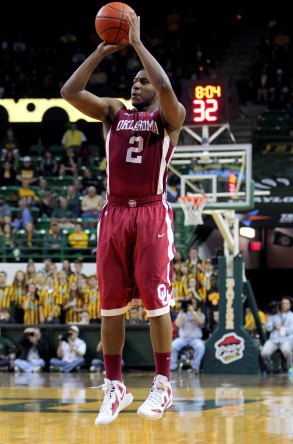
Matt Williams
Garnering Honorable Mention All-Conference honors last season, Steven Pledger was one of the most pleasant surprises in the Big XII as a junior. A fringe top-100 prospect , Pledger committed to play for Jeff Capel out of Atlantic Shores Christian HS. Developing a reputation as a dangerous jump shooter, the San Diego-born, Chesapeake-raised guard played a complementary role in his first two seasons at the collegiate level. Sticking around in Norman after Capel was fired in the spring of 2011, Pledger led the team with 16.2 points per-game in an expanded role for first-year Head Coach Lon Kruger last year.
Standing 6'4 with a 225-pound frame, Pledger is a well-built shooting guard who does most of his damage with his jump shot. Possessing subpar quickness and leaping ability for his position at the NBA level, Pledger could fit the mold of a perimeter-oriented offensive roleplayer who can spread the floor and take what defenses give him off the dribble.
A big part of Pledger's ability to fill such a role is based on his ability to hit shots from distance. Shooting 41.6% from 3-point range last season, Pledger is a dangerous spot-up threat who shoots the ball with great confidence and great follow-through. A capable shooter running off of screens and pulling up off the dribble as well, Pledger made 41.4% of his jump shots overall last season according to Synergy Sports Technology, a key number considering nearly 84% of all of his shot attempts were jumpers.
As a junior, Pledger also got the opportunity to create his own shot on the pick and roll in some sets, something that had not been as significant a part of his role earlier in his career. Lacking great ball-handling ability or the speed to turn the corner consistently, Pledger is a not a very shifty player with the ball in his hands one-on-one, but his ability to make sound decisions with the ball, take what defenses gave him at the rim, and pull-up and hit shots, even with a hand in his face, made him a serviceable threat in the two-man game last year.
Looking ahead to the coming season, the name of the game for Pledger will be consistency. In the last 10 games of the 2012 campaign, Pledger scored 0.872 points per-possession, down from the 1.100 he posted over the first 21 games of the year. Slowed by defensive gameplans that were geared towards chasing him off the line and not giving Oklahoma anything easy in transition, Pledger will need to show that he can maintain his efficiency from the perimeter even when shouldering the burdens associated with being his team's first-option.
Defensively, Pledger plays with a decent motor, but gets caught overcommitting to help when defending off the ball too frequently and doesn't have the lateral quickness to consistently overcome those lapses. Pledger's aggressiveness makes life a little bit easier for his teammates, but he'll need to do a better job splitting the difference and recovering to his man to give up fewer shots from the perimeter. In one-on-one situations, Pledger's strength helps him hold his ground, but questions remains about his ability to defend his position at the NBA level.
A player who can put points on the board in a hurry when he gets hot, Steven Pledger is not a glamorous NBA prospect, but has shown incremental improvement each year he has been at Oklahoma and is one of the top returning scorers in the Big XII. If he can be a more consistent defender and mesh with Lon Kruger's first haul of freshman and transfers to be more effective offensively, he could put together a good year. A prototypical candidate for the Portsmouth Invitational Tournament, Pledger will be a name to keep an eye on in the new-look Big XII.
#9, Cory Jefferson, 6-9, PF/C, Junior, Baylor
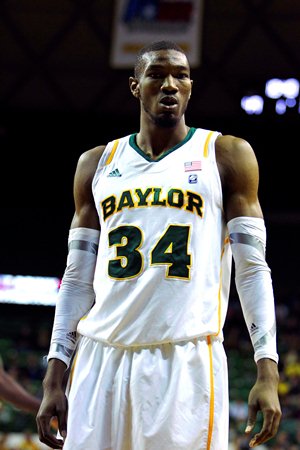
Jonathan Givony
Playing just 454 total minutes in his first three years at Baylorone of which he redshirtedCory Jefferson has yet to truly receive much of an opportunity to show what he can do at the collegiate level. With fellow big men Quincy Acy and Perry Jones off to the NBA now, though, this might be the year that he gets a chance.
Jefferson's calling card as a NBA prospect revolves around his combination of physical tools and shot-blocking prowess. Standing 6-9, he possesses a narrow frame that should fill out in time, as well as a very long wingspan. He's a solid athlete on top of that, running the floor well and being capable of playing above the rim with ease.
A fairly limited offensive player, Jefferson scored just 3.6 points per game in 10.5 minutes last season. Pretty aggressive looking to receive the ball with his back to the basket, he doesn't possess the strength or footwork to be a very attractive target at this stage against better competition. That doesn't seem to stop him from trying, though. He's dished out just 3 assists in 454 total minutes at Baylor thus far, as it's pretty clear that he is not looking to create any easy looks for anyone once he catches the ball.
Where Jefferson is at his best is as a finisher, where his terrific length and explosiveness make him a very reliable target for dump-off passes from his guards, and will allow him to make an occasional highlight reel via the offensive glass. He doesn't look to have much in the ways of a jumper or ball-handling skills, leaving him mostly at the mercy of his guards to create offense for him.
While Jefferson's skill-level offensively isn't particularly impressive, he's actually fairly advanced on the defensive side of the ball. His tremendous length and mobility help him out quite a bit here, but he also shows great patience, awareness and confidencealmost the exact opposite of his work on the offensive end. Blessed with excellent timing as a shot-blocker, Jefferson simply changes everything around the rim, rejecting 4.6 shots per-40 minutes pace-adjusted. This would have been the second best rate in the Big 12 last year had he played enough minutes to qualify, so it will be interesting to see what he can do with more burn.
He's not without flaws here either, though. Due to his lack of strength, he has some issues keeping stronger players from backing him down inside the paint, causing him to foul at a relative high rate. He defended primarily centers last season, something he likely won't be able to do at the professional level with his skinny build standing just 6-9. Can he guard power forwards who step outside and attack off the dribble? That remains to be seen. His rebounding rate wasn't particularly impressive last season either, especially offensively considering how small a role he played there.
With highly touted freshmen big men Isaiah Austin and Ricardo Gathers entering the fold for Baylor, Jefferson will have to show improvement to show he's worthy of more consistent playing time than he's seen the past two years. Turning 22 this December, he's already older than most of the players in his class, so this will be an important season for him to show that he's more than just an impressive physical specimen.
#10, Sheldon McClellan, 6-5, Shooting Guard, Sophomore, Texas
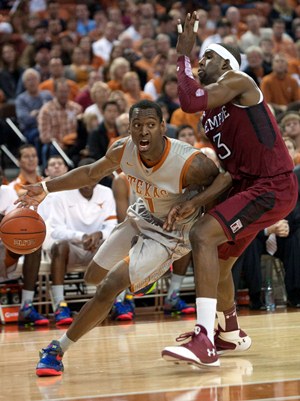
Joe Treutlein
After a strong freshman season in which he ranked second on the Longhorns in scoring, Sheldon McClellan could be poised for a breakout season as a sophomore, as last year's leading scorer J'Covan Brown has since departed for the NBA.
Standing 6'5 with very good length, a solid frame, and very good athletic abilities, Sheldon McClellan has ideal attributes for a shooting guard at any level. These attributes weren't always consistently on display in his offensive game as a freshman, however, as he was mostly asked to simply fill a role, specifically that of a spot-up shooter.
On the offensive end, McClellan made most of his contributions shooting the ball last season, as 67.4% of his half-court shot attempts were of the jump shot variety last season according to Synergy Sports Technology. McClellan has excellent mechanics both spotting up and pulling up off the dribble, showing good elevation and a high and consistent release point. McClellan took nearly twice as many jumpers spotting up as compared to off the dribble, but actually is more impressive with his ability to convert off the dribble, as his 0.944 points per shot pulling up is almost as efficient as his 0.99 spotting up.
McClellan does most of his damage off the dribble operating with simple moves in small areas, usually starting with a jab step or ball fake and taking one or two dribbles into a quick pull-up shot. He has no problems creating separation and doesn't need much space to get off his shot. On the down-side for McClellan, his 31% three-point shooting last season wasn't impressive, and is something he'll definitely want to improve on this year. He should be relied upon much more heavily to create offense for the Longhorns, however, so improving his efficiency while having to take more difficult shots won't be an easy task.
McClellan wasn't a very strong factor taking the ball to the basket as a freshman, seeing the vast majority of his offensive touches coming on the perimeter. He didn't show much in terms of advanced ball-handling, though it is something he utilized in his high school days so it will be interesting to see how much more he shows in this area this year. McClellan's lack of attempts taking the ball to the basket was a big boon to his overall efficiency as a freshman, as it played a big role in how he managed to average just 0.1 turnovers per possession, which is extremely low for a guard.
At the basket, McClellan wasn't a very good finisher as a freshman, but shows potential with his size and leaping ability. In addition to not taking the ball frequently to the basket himself, he wasn't utilized much on cuts either, so how he fares in this area as he expands his offensive role this season is certainly something to watch for.
On the defensive end, McClellan also has a lot of room to improve, as despite showing a good opening stance on most plays, he doesn't always put in the effort to really lock down his man, getting beat far more often than he should. While his tools allow him to be a solid collegiate defender without putting in maximal effort, really putting in the energy on this end of the floor could allow him to be a real force and is certainly something that could help his stock considerably.
Looking forward, it's tough to make concrete projections about McClellan from his freshman season given the relatively small and well-defined role he often played, though it's clear he has potential in many areas of the game. Improving his shooting numbers to match the expectations many have for him will certainly be key for his stock going forward, but taking his game to the next level defensively and adjusting well to a likely expanded shot-creator role this season will also be very important. While it's tough to take an accurate gauge of his draft stock now, things could be much different in a few months, and that makes McClellan one of the more interesting draft prospects to watch this year.
#11, Jordan Tolbert, 6'7, Sophomore, Power Forward, Texas Tech
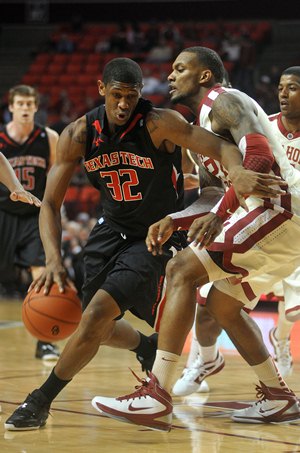
Matt Williams
A largely unheralded recruit coming out of high school, Jordan Tolbert was one of the most productive freshman in the Big XII last season. Averaging 11.5 points and 5.7 rebounds for a Texas Tech team that finished 1-17 in conference play, the young power forward emerged as an intriguing long-term prospect amidst his team's struggles. Headed back to Lubbock for his sophomore year, Tolbert is a player to keep an eye on as the Red Raiders look to pick up the pieces after a tumultuous offseason.
Standing 6'7 with a big wingspan and a 210-pound frame that should fill out in time, Jordan Tolbert is physically similar to former San Diego State prospect Malcolm Thomas. He is undersized for the power forward position, but is a terrific athlete who runs the floor well and dunks almost everything around the basket, sometimes in impressive fashion.
At this point in his career, Tolbert's offensive game is largely inconsistent and almost entirely predicated on his ability to use his athleticism in different situations. Despite lacking much in the way of advanced post moves, nearly 40% of Tolbert's offense comes in back to the basket situations. He converted an impressive 49.1% of those touches by outworking his man for position on the block and making strong, explosive moves to the basket last season. His touch is still a work in progress, and he needs to become more confident with his left hand and develop a more polished repertoire to become more consistent and prepare himself for the next level, but he quickly proved to be an effective post scorer in the college game.
In addition to his post scoring, Tolbert is an excellent catch and finish threat, looking to dunk everything at the rim. He does a good job crashing the offensive glass and moving without the ball, earning himself some easy looks by virtue of his consistently high energy level on this end of the floor. When he doesn't have an open lane to the rim, the Texas native has room for improvement. He forces some difficult short range shots over defenders, appearing out of control and trying to do a bit too much at times.
If Tolbert can become a bit more patient and develop his skill level facing the rim, he should be able to improve on already-solid 57% shooting at the rim and become a more dangerous offensive player on the whole. As a jump shooter, Tolbert made 8 of the 20 shots he attempted last year, looking confident on his makes, but still clearly only just developing that part of his game and needing to become more consistent with his mechanics. As Tolbert begins to improve his face-up game, he'd be well served to shore up his ball-handling ability as well, as his explosiveness could make him an effective slasher from the midrange.
Defensively, Tolbert had some good and bad moments in his first season of college basketball. He needs to improve his fundamentals, and will always be at a disadvantage against bigger forwards on the block, but plays with energy and does a nice job defending face-up big men away from the basket. Tolbert's ability to get stronger and fight for position on the block will be a key to his success on this end of the floor as he gave up some easy baskets after allowing his man to catch the ball with two feet in the paint and could always keep his man off the glass last season.
Moving forward, the name of the game for Jordan Tolbert is consistency and improvement. He struggled to make his presence felt for stretches as a freshman, but led Texas Tech in scoring through those growing pains nonetheless and showed some promising attributes and potential in the process. Likely to play a huge role for his team in coming seasons, if he can continue improving his ability to score away from the basket, he'll be a player to keep an eye on in the future.













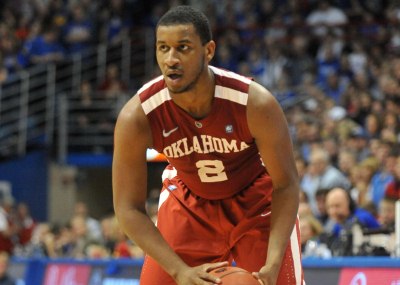












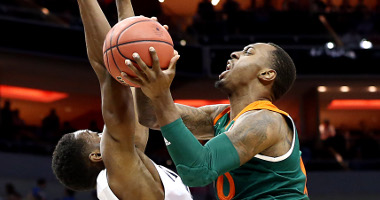















Comments